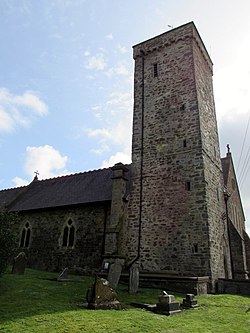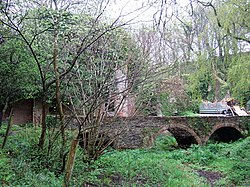Prendergast
| Prendergast | |
| Pembrokeshire | |
|---|---|
 Mediæval tower of St David's Church | |
| Location | |
| Location: | 51°48’36"N, 4°57’36"W |
| Data | |
| Post town: | Haverfordwest |
| Postcode: | SA62 |
| Local Government | |
| Council: | Pembrokeshire |
| Parliamentary constituency: |
Preeli Pembrokeshire |
Prendergast is an ancient parish in Pembrokeshire, that forms a suburb of Haverfordwest, Pembrokeshire's county town. The Western Cleddau forms the parish's western boundary, and the Hiog, a tributary of the Cleddau, the eastern boundary.[1]
Contents
Name
The origin of the village's name is possibly linked to a family named Prendergast, whose earliest-known ancestor was Maurice, a Norman. The name may be Norman or Flemish; scholars differ, and there are arguments for either.[2]
History
Parish
Prendergast (Prendergest) appears on a 1578 parish map of Pembrokeshire.[3]
The parish, in the hundred of Dungleddy (and before that in the pre-Norman cantref of Deugleddyf)[4] was considered a suburb of Haverfordwest as long ago as the mid-19th century, at which time it had 1,105 inhabitants,[5] but was still referred to as a village.[1] In 1872, the parish was said to extend to 1,104 acres, and in the 150 years between 1801 and 1951 the population almost doubled from 814 to 1,543.[6] In 1831, agriculture was a minor industry, with most people employed in retail and handicrafts.[7]
Parish church
The parish church of St David is a Grade-II listed building, and has many memorials to distinguished local people. It was described in 1833 as "an ancient and venerable structure, in the early style of English architecture, and in good repair",[1] but by 1872 was "in disrepair".[5] It was rebuilt in the late 19th century, but retains its late-mediaeval tower.[8]
Chapel
A Welsh-speaking Baptist Chapel was established in 1858 to serve north Pembrokeshire people settling in Haverfordwest. Welsh-only services ceased in 1880, and the chapel was enlarged in 1888–91.[9]:369
Prendergast Mill
About 1786, the three-storey cotton mill—possibly the only one in south Wales, or at least the largest, with 1,512 spindles—began an industrial complex on the Cleddau River. It was converted to a paper mill in 1816, establishing the paper-making industry in Haverfordwest, but by the end of the century was disused. In ruins by the 20th century, it was partially demolished in 1986. The bridge over the mill race—now no longer running— was constructed in 1812, is a Grade II listed structure and is still in use.[9]:92[10][11][12]
Rebecca riots
With few turnpike tollgates in Pembrokeshire escaping from the Rebecca rioters of the early 1840s, Prendergast was no exception; on 6 April 1843, about 24 men destroyed the tollgate on the Fishguard road.[13] In the spring of 1844, two men were convicted of unlawful assembly in the previous August, and sentenced to 12 months' imprisonment each.[14]
Education
A primary school was established in the village in 1876.[9]:369 Sir Thomas Picton School was established in 1954, and closed in 2018 as part of a school merger.[15]
Notable people
Maurice de Prendergast was a Norman knight (fl. 1169–1174) who participated in Norman invasion of Ireland, launched from Pembrokeshire.[16][17] The Stepney family were prominent in Prendergast from the mid-1500s to mid-1700s.[18] Their seat, Prendergast House, was in ruins by the late 18th century.[9]:368
Today
The present-day ecclesiastical parish of Prendergast with Rudbaxton is in the Diocese of St Davids.[19] Prendergast now includes the trading estates of Withybush, and Withybush General Hospital, as well as some new and older residential properties and a school, and is divided approximately north-south by a spur of the main A40 road into Haverfordwest town centre, and north-east to south-west by the B4329 road from Cardigan.[20]
There are several other listed buildings in the parish.[21]
References
- ↑ 1.0 1.1 1.2 "GENUKI: Prendergast". https://www.genuki.org.uk/big/wal/PEM/Prendergast. Retrieved 9 August 2019.
- ↑ "Prendergast Family". Archaeologia Cambrensis, 1865, Series 3, No. LVI (National Library of Wales): 67. https://journals.library.wales/view/2919943/2996217/70#?xywh=-1228%2C-209%2C4634%2C3912. Retrieved 10 August 2019.
- ↑ "Penbrok comitat". British Library. https://www.bl.uk/onlinegallery/onlineex/unvbrit/p/zoomify83390.html. Retrieved 9 August 2019.
- ↑ Charles, B. G. (1992). The Placenames of Pembrokeshire. Aberystwyth: National Library of Wales. p. 395. ISBN 0-907158-58-7.
- ↑ 5.0 5.1 "A Vision of Britain through Time: GB Historical GIS / History of Prendergast in Pembrokeshire". University of Portsmouth. http://www.visionofbritain.org.uk/place/8517. Retrieved 9 August 2019.
- ↑ "A Vision of Britain through Time: GB Historical GIS / History of Prendergast in Pembrokeshire". University of Portsmouth. http://www.visionofbritain.org.uk/unit/10487640/cube/TOT_POP. Retrieved 9 August 2019.
- ↑ "A Vision of Britain through Time: GB Historical GIS / History of Prendergast in Pembrokeshire". University of Portsmouth. http://www.visionofbritain.org.uk/unit/10487640/cube/OCC_PAR1831. Retrieved 9 August 2019.
- ↑ Cadw Church of St David (Grade II) (12039) Retrieved 9 August 2019.
- ↑ 9.0 9.1 9.2 9.3 Lloyd, Thomas; Orbach, Julian; Scourfield, Robert (2004). Pembrokeshire: The Buildings of Wales (Pevsner Architectural Guides: Buildings of Wales) (First ed.). New Haven, CT: Yale University Press. p. 369. ISBN 978-0-300-10178-2.
- ↑ "RCAHMW List of Historic Place Names: Prendergast Paper Mill". https://historicplacenames.rcahmw.gov.uk/placenames/recordedname/b1f6d929-c26b-4603-8c3d-22eda4196883. Retrieved 10 August 2019.
- ↑ Cadw Bridge at Prendergast Mill (Grade II) (13038) Retrieved 10 August 2019.
- ↑ "Coflein: Prendergast Mill". https://coflein.gov.uk/en/site/41243/details/prendergast-millcotton-millpaper-mill-haverfordwest. Retrieved 10 August 2019.
- ↑ Evans, Henry Tobit (2010). Rebecca Riots!. David M Gross. p. 36. ISBN 9781451590869. https://books.google.co.uk/books?id=s-fTr6Pgi-UC&dq=Scleddy&source=gbs_navlinks_s.
- ↑ "Rebecca and her daughters". https://archive.org/stream/rebeccaherdaught00evanuoft/rebeccaherdaught00evanuoft_djvu.txt. Retrieved 12 August 2019.
- ↑ Wightwick, Abbie (28 January 2019). "Nearly 200 schools have shut in Wales since 2013". Wales Online. https://www.walesonline.co.uk/news/education/nearly-200-schools-shut-wales-15722574. Retrieved 1 February 2019.
- ↑ Expugnatio Hibernica:The Conquest of Ireland, p. 293, 294, 295, 296-97, 298, 299, 301, 302, 307, 308, 321, by Giraldus Cambrensis, ed. A.B. Scott and F. X. Martin, 1978. ISBN 0-901714-11-9
- ↑ Duffy, Seán (2005). Medieval Ireland An Encyclopedia. Routledge. ISBN 0-415-94052-4.
- ↑ Charles, B. G., (1959). "STEPNEY (or STEPNETH) family, of Prendergast, Pembrokeshire". Dictionary of Welsh Biography. https://biography.wales/article/s-STEP-NEY-1559. Retrieved 10 Aug 2019.
- ↑ "Diocese of St David's: Prendergast and Rudbaxton". https://stdavids.churchinwales.org.uk/prendergast/. Retrieved 9 August 2019.
- ↑ Ordnance Survey Explorer Map OL36: South Pembrokeshire, 2009
- ↑ "British Listed buildings in SA62 4EF". https://britishlistedbuildings.co.uk/search/?q=SA62+4EF#.XU1u-pNKhbU. Retrieved 9 August 2019.
